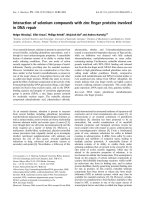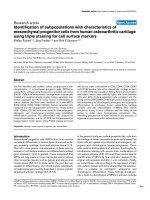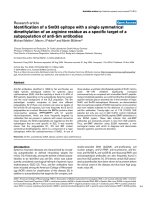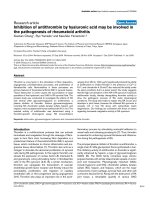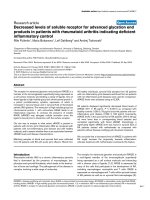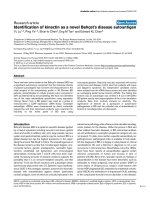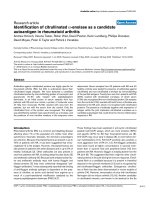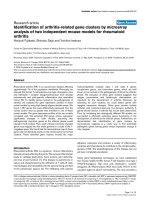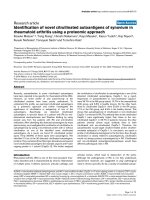Báo cáo y học: "Identification of new autoantibody specificities directed at proteins involved in the transforming growth factor b pathway in patients with systemic sclerosis" pot
Bạn đang xem bản rút gọn của tài liệu. Xem và tải ngay bản đầy đủ của tài liệu tại đây (1.46 MB, 13 trang )
RESEARCH ARTICLE Open Access
Identification of new autoantibody specificities
directed at proteins involved in the transforming
growth factor b pathway in patients with
systemic sclerosis
Guillaume Bussone
1,2
, Hanadi Dib
1,2
, Mathieu C Tamby
1,2
, Cedric Broussard
3
, Christian Federici
3
,
Geneviève Woimant
4
, Luc Camoin
3
, Loïc Guillevin
5
and Luc Mouthon
1,2,5*
Abstract
Introduction: Antinuclear antibodies (ANAs), usually detected by indirect immunofluorescence on HEp-2 cells, are
identified in 90% of patients with systemic sclerosis (SSc). Thus, approximately 10% of SSc patients have no
routinely detectable autoantibodies, and for 20% to 40% of those with detectable ANAs, the ANAs do not have
identified specificity (unidentified ANAs). In this work, we aimed to identify new target autoantigens in SSc patients.
Methods: Using a proteomic approach combining two-dimensional electrophoresis and immunoblotting with
HEp-2 cell total and enriched nuclear protein extracts as sources of autoantigens, we systematically analysed
autoantibodies in SSc patients. Sera from 45 SSc patients were tested in 15 pools from groups of three patients
with the same phenotype. A sera pool from 12 healthy individuals was used as a control. Proteins of interest were
identified by mass spectrometry and analysed using Pathway Studio software.
Results: We identified 974 and 832 protein spots in HEp-2 cell total and enriched nuclear protein extracts,
respectively. Interestingly, a-enolase was recognised by immunoglobulin G (IgG) from all pools of patients in both
extracts. Fourteen and four proteins were recognised by IgG from at least 75% of the 15 pools in total and
enriched nuclear protein extracts, respectively, whereas 15 protein spots were specifically recognised by IgG from
at least four of the ten pools from patients with unidentified ANAs. The IgG intensity for a number of antigens was
higher in sera from patients than in sera from healthy controls. These antigens included triose phosphate isomerase,
superoxide dismutase mitochondrial precursor, heterogeneous nuclear ribonucleoprotein L and lamin A/C. In
addition, peroxiredoxin 2, cofilin 1 and calreticulin were specifically recognised by sera from phenotypic subsets of
patients with unidentified ANAs. Interestingly, several identified target antigens were involved in the transforming
growth factor b pathway.
Conclusions: We identified several new target antigens shared among patients with SSc or specific to a given
phenotype. The specification of new autoantibodies could help in understanding the pathophysiology of SSc.
Moreover, these autoantibodies could represent new diagnostic and/or prognostic markers for SSc.
* Correspondence:
1
Institut Cochin, Université Paris Descartes, CNRS UMR 8104, 8 rue Méchain,
F-75014 Paris, France
Full list of author information is available at the end of the article
Bussone et al. Arthritis Research & Therapy 2011, 13:R74
/>© 2011 Bussone et al.; licensee BioMed Central Ltd. This is an open access article distributed under the terms of the Creative Commons
Attribution Licens e ( which permits unrestricte d use, distribution, and reproduction in
any medium, provided the original work is prop erly cited.
Introduction
Systemic sclerosis (SSc) is a connective tissue disorder
characterised by excessive collagen deposition in the
derm is and internal organs, vascular hyperreac tivity and
obliteration phenomena [1]. A large number of autoanti-
bodies have been identified in the sera of SSc patients.
Antinuclear antibodies (ANAs), usually de tected by
indirect immunoflu orescen ce on HEp-2 cells, are identi-
fied in 90% of patients [2]. Some of them are disease-
specific and mutually exclusive: anticentromere antibo-
dies (ACAs), associated with limited cutaneous SSc
(lcSSc) and possibly pulmona ry arterial hypertension
(PAH); anti-topoisomerase I antibodies (ATAs), asso-
ciated with diffuse cutaneous SSc (dcSSc) and interstitial
lung disease (IL D); and anti-RNA polymerase III antibo-
dies, associated with dcSSc and scleroderma renal crisis
(SRC) [3]. In addition, other autoantibodies have been
found in the sera of SSc patients and include antifibril-
larin, antifibrillin 1, anti-Th/To, anti-PM/Scl [3], antifi-
broblast [4-6] and anti-endothelial cell antibodies [7-9].
Overall, t he only specific autoantibodies routinely tested
for in SSc patients are ACAs, ATAs and, more recently,
anti-RNA polymerase III antibodies.
Thus, approximately 10% of SSc patients have no routi-
nely detectable autoantibodies, and for 20% to 40% o f
those with detectable ANAs, the nuclear target antigens
of these ANAs have not been identified [2]. Therefore,
further work is warranted to better determine the disease
subset and prognosis for these patients. The specification
of new autoantibodies could help in understanding the
pathophysiology of SSc and reveal new diagnostic and/or
prognostic markers.
Using a proteomic approach combining two-dimen-
sional electrophoresis (2-DE) and immuno blotting, we
recently identified target antigens of antifibroblast anti-
bodies in patients with PAH [10]. In this work, using a
similar proteomic approach with total and enriched
nuclear protein extracts of HEp-2 cells as sources of
autoantigens, we systematically analysed autoantibodies
in SSc patients and identified a number of new target
antigens for these autoantibodies.
Materials and methods
Immunoglobulin sources
Sera were obtained from 45 patients who fulfilled the
LeRoy and Medsger criteria and/or the American Rheu-
matism Association criteri a for the diagnosis of SSc. Sera
were tested in 15 pools from groups of t hree patients
withthesamephenotypeasdescribedpreviously[10].
Four pools were from patients with identified ANAs (that
is, ACAs, ATAs o r anti-RNA polymerase III antibodies),
ten pools w ere from patients w ith unidentified ANAs,
and one pool was from patients without ANAs (Table 1).
The sera from three patients with anti-RNA polymerase
III antibodies who had experienced SRC were included in
oneofthetwopoolsfrompatientswithSRC.ANAsand
ACAs were investigated by indirect immunofluorescence
on HEp-2 cells; ACAs were characterised by a centro-
mere pattern; ATAs and anti-RNA polymerase III anti-
bodies were detected by using an enzyme-linked
Table 1 Characteristics of pools of sera used as sources of IgG
a
Main clinical characteristics Autoimmunity Number of pools tested
b
Healthy blood donors No ANA 1
dcSSc
No visceral involvement No ANA 1
Interstitial lung disease ATA 1
Scleroderma renal crisis Anti-RNA-pol III Abs 1
lcSSc
Pulmonary arterial hypertension ACA 1
No visceral involvement ACA 1
dcSSc
Scleroderma renal crisis ANA with unidentified specificity 1
Pulmonary arterial hypertension ANA with unidentified specificity 1
Interstitial lung disease ANA with unidentified specificity 2
No visceral involvement ANA with unidentified specificity 1
lcSSc
Digital ulcers ANA with unidentified specificity 1
Pulmonary arterial hypertension ANA with unidentified specificity 1
Interstitial lung disease ANA with unidentified specificity 1
No visceral involvement ANA with unidentified specificity 2
a
Abs: antibodies; ACA: anticentromere antibody; ANA: antinuclear antibody; anti-RNA-pol III Abs: anti-RNA polymerase III antibodies; ATA: antitopoisomerase I
antibody; dcSSc: diffuse cutaneous systemic sclerosis; lcSSc: limited cutaneous systemic sclerosis; SSc: systemic sclerosis.
b
A pool of sera from 12 healthy blood
donors was tested as a control. Immunoglobulin G reactivities were tested in pools of three sera from patients with the same phenotype of SSc.
Bussone et al. Arthritis Research & Therapy 2011, 13:R74
/>Page 2 of 13
immunosorbent assay (ELISA) kit (INOVA Diagnostics,
San Diego, CA, USA).
We used a pool of sera from 12 healthy blood dono rs
as a control. Healthy controls (HCs) had no detectable
disease, no remarkable medical history and no ANAs
and were not taking any m edication at the time of
blood sampling. Serum samples were stored in aliquots
at -80°C.
All patie nts and HCs gave their writte n informed
consent according to the policies o f the ethics commit-
tee of Cochin Hospital. They were included in the
Hypertension Artérielle Pulmonaire (HTAP)-Ig study
(Investigation and Clinical Research’s contract 2005,
CIRC 05066 , promoter Assistance Publique-Hôpitaux de
Paris).
HEp-2 cell culture
HEp-2 cells, a cell line derived from a human laryngeal
carcinoma, were obtained from EuroBio (Les Ulis,
France) and cultured as described previously [8]. When
confluent, the cells were detached by use o f 0.05% tryp-
sin-ethylenediaminetetraacet ic acid (EDTA) (Invitrogen,
Carlsbad, CA, USA).
Protein extraction
Total proteins were extracted from HEp-2 cells as
described previ ously [11]. Briefly, H Ep-2 cel ls were sus-
pended in a sample solution extraction kit (Bio-Rad
Laboratories, Hercules, CA, USA) containing 2%
(wt/vol) sulfobetaine zwitterionic detergent (SB 3-10)
and the carrier ampholyte Bio-Lyte 3/10 (Bio-Rad
Laboratories). Cell samples were sonicated on ice, and
the supernatant was collected after ultracentrifugation.
Finally, after protein quantification [12], 64 mM dithio-
threitol (Sigma-Aldrich, St. Louis, MO, USA) was added,
and the supernatant was aliquoted and stored at -80°C.
A protein extract enriched in nuclear proteins was
obtained as previously described [13], which is referred
to hereinafter as enriched n uclear protein extract.
Briefly, HEp-2 cells were suspended in a buffer contain-
ing 10 mM 4-(2-hydroxyethyl)-1-piperazineethanesulfo-
nicacid(HEPES),pH7.9,10mMKCl,0.1mMEDTA,
0.1 mM ethyleneglycoltetraacetic acid (EGTA), 1 mM
dithiothreitol and antiproteases. After incubation for 15
minutes on ice, 10% Nonidet P-40 (Sigma-Aldr ich) was
added and cells were v ortexed. Cells were then resus-
pended, incubated for 15 minutes on ice and regularly
vortexed in a buffer containing 20 mM HEPES, pH 7.9,
0.4 M NaCl, 1 mM EDTA, 1 mM EGTA, 1 mM dithio-
threitol and antiproteases. After ultracentrifugation, the
supernatant was washed in a precooled (-20°C) solution
of 10% trichloroacetic acid in acetone with 0.07% 2-mer-
captoethanol (Sigma-Aldrich) to eliminate salts as
described previously [13]. Proteins were resuspended in
the sample solution extraction kit and then quantified
[12]. Finally, 64 mM dithiothrei tol was add ed, and the
sample was aliquoted and stored at -80°C.
Two-dimensional electrophoresis
The study protocol is depicted in Figur e 1. We used a pH
range of 3.0 to 10.0 a nd an acrylamide gradient of 7% t o
18%,whichallowedustostudyawiderangeofantigens
of 10 to 250 kDa [11,14]. Proteins were isoelectrofocused
with 17-cm immobilised pH gradient strips on the
Protean IEF Cell System (Bio-Rad Laboratories) as
described previously [11]. Thus, 100 μg of HEp-2 cell
proteins from total or enriched nuclear protein extracts
were loaded onto each strip. Before the second dimen-
sion, the strips were equilibrated and then proteins were
transferred to gels as described previously [11,13]. Finally,
one gel was stained w ith ammoniaca l silver nitrate to
serve as a reference for analysis of 2-D immunoblots [14].
Electrotransfer and immunoblotting
After migrati on, proteins were transferred onto polyviny-
lidene difluoride memb ranes (Millipore, Bill erica, MA,
USA) by semidry transfer (Bio-Rad Laboratories) at 320
mA for 90 minutes. After being blocked, membranes
were incubat ed overnight at 4°C w ith each of the sera
pools from HCs and patients at a 1:100 dilution. Immu-
noglobulin G (IgG) immunoreactivities were revealed as
described previously [11]. Specific reactivities were deter-
mined by densitometrically scanning the membrane s
(GS-800 calibrated densitometer; Bio-Rad Laboratories)
with Quantity One software (Bio-Rad Laboratories). The
membranes were then stained with colloidal gold (Proto-
gold;BritishBiocellInternational,Cardiff,UK)and
underwent secondary densitometric analysis to record
labelled protein spots for each membrane.
Images of the referen ce gel and membran es were
acquired by using the GS-800 calibrated densitometer
and were analysed by u sing ImageMaster 2D Platinum
6.0 software (GE Healthcare , Buckinghamshire, UK) as
described previously [11].
In-gel trypsin digestion
Relevant spots were s elected by comparing the 2-D
immunoblots with the silver-stained reference gel and
then extracted from another gel stained with Coomassie
brilliant blue (Sigma-Aldrich). In-gel digestion involved
the use of trypsin as described previously [13], and for
all steps a Freedom EVO 100 digester/spotter robot was
used (Tecan, Männedorf, Switzerland).
Protein identification by mass spectrometry
Protein identification involved the use of a matrix-
assisted laser desorption/ionization time of flight
(MALDI-TOF)-TOF 4800 mass spectrometer (Applied
Bussone et al. Arthritis Research & Therapy 2011, 13:R74
/>Page 3 of 13
Biosystems, Foster City, CA, USA) as previously
reported [13]. Database searching involved the use of
Mascot 2.2 software (Matrix Science, London, UK) and
the GPS Explorer version 3.6 program (Applied Biosys-
tems) to combine mass spectrometry (MS) and tandem
mass spe ctrometry (MS/MS) queries of huma n proteins
from the Swiss-Prot database [15].
Biological network analysis
Protein lists of interest were analysed using Pathway
Studio software (Ariadne, Rockville, MD, USA) [16].
Pathway Studio is a pathway analysis tool that uses
automated t ext-mining engines to extract information
from the literature. Briefly, protein lists were run against
ResNet 7.0, a database of biological relations, ontologies
and pathways. ResNet 7.0 covers human, mouse and rat
proteins. The filters applied included “all shortest paths
between selected e ntities” and “expand pathway”.The
informa tion received was narrowed down to our protein
lists to obtain their relationships. Protein entities
belonging to different functional groups were repre-
sented as different shapes.
Figure 1 E xperimental design for screening anti-HEp-2 cell ant ibodies and identifying target autoantigens in SSc patients. HEp-2 cell
proteins were extracted and separated on two-dimensional (2-D) gels. Total and enriched nuclear protein extracts were used as substrates for 2-
D electrophoresis. One gel was stained with silver nitrate and used as the reference gel, and proteins of the 11 other gels were transferred onto
polyvinylidene difluoride (PVDF) membranes. Membranes were immunoblotted at 1:100 dilution with pooled sera from 12 healthy blood donors
or from sets of three patients with the same phenotype of systemic sclerosis (SSc). After immunoglobulin G (IgG) immunoreactivities were
revealed, the 2-D immunoblots were stained with colloidal gold to visualize the transferred proteins. 2-D immunoblots were scanned before and
after colloidal gold staining with the use of a densitometer, then analysed by using image analysis software, and finally compared with the
reference gel. Selected protein spots were extracted from another gel stained with Coomassie brilliant blue, and candidate proteins were
identified by mass spectrometry. Database searching was used to identify the antigens.
Bussone et al. Arthritis Research & Therapy 2011, 13:R74
/>Page 4 of 13
Statistical analysis
Data are presented as mean values ± standard deviation.
Positive identification of proteins by MALDI-TOF-TOF
was based on a s tatistically significant Mascot score
(P < 0.05). For peptides matching multiple members of a
protein family, the reported protein is the one with the
highest number of peptide matches.
Results
Analysis of HEp-2 cell proteomes
We found 974 and 832 protein spots specifically
stained by silver nitrate in HEp-2 cell total and
enriched nuclear protein extracts, respectively (Figures
2B and 2E and Additional file 1). Major differences
were observed between the two HEp-2 cell proteomes,
corresponding to quantitative variation for a given pro-
tein spot as well as protein spots that were exclusively
detected in one of the two protein extracts. In the
total protein extract, a large number of protein spots
stained with high intensity migrated between pH 4.0
and 7.0 and between 100 and 10 kDa. In the enriched
nuclear protein extract, a lower number of protein
spots was stained with high intensity and migrated
between pH 5.0 and 9.0 and, with several exceptions,
between 75 and 30 kDa.
After protein transfer and colloidal gold staining, we
identified 658 ± 101 and 535 ± 66 protein spots on
average per membrane in total and enriched nucle ar
protein extracts, respectively (data not shown). Again,
quantitative and/ or qualitative differences were observed
between membranes transferred with one or the other
of the protein extracts.
IgG reactivities shared between SSc patients
In the 15 pools of sera from SSc patients, IgG recog-
nised, on average per membrane, 142 ± 34 and 155 ±
47 protein spots in HEp-2 cell total and enriched
nuclear protein extracts, respectively, with no significant
difference between sera pools (data not shown). Overall,
43 and 33 protein spots were recognised by at least 75%
of pools from patients with dcSSc and/or lcSSc in total
and enriched nuclear protein extracts, respectively
(Additional files 2 and 3). Thus, 14 and 4 proteins were
identified by MS from the protein spots recognised by
at least 75% of the 15 pools in total and enriched
nuclear protein extracts, respectively (Table 2). A
limited number of proteins were recognised by IgG
from all pools of patients. All of these latter proteins
were also recognised by IgG from HCs. Interestingly,
a-enolase was recognised by IgG from all pools of
Figure 2 IgG reactivities directed t oward triosephosphate isomerase, superoxide dismutase mitochondrial precursor and
heterogeneous nuclear ribonucleoprotein L. (A) areas of 2-D membranes with IgG reactivities directed toward triosephosphate isomerase
(rectangles) and superoxide dismutase mitochondrial precursor (ovals) in sera from patients with different subsets of SSc and from healthy blood
donors in total protein extract. (D) Areas of 2-D membranes with IgG reactivities directed toward heterogeneous nuclear ribonucleoprotein L in
sera from SSc patients with unidentified ANA and from healthy blood donors in enriched nuclear protein extract. 2-D silver-stained gel of total
(B) and nuclear (E) protein extracts from HEp-2 cells. First dimension (x-axis): pH range from 3 to 10; second dimension: range from 150 to 10
kDa (y-axis). The areas delineated by rectangles in B (pH 6.5 to 7.8; 22 to 28 kDa) and D (pH 7.1 to 7.7; 55 to 65 kDa) correspond to the region of
membranes magnified in A and D, respectively. (C and F) 3-D representation of IgG reactivity peaks in a sera pool from three patients (left) and
from the 12 healthy blood donors (right). ACA: anticentromere antibody; ANA: antinuclear antibody; ATA: antitopoisomerase I antibody; dcSSc:
diffuse cutaneous systemic sclerosis; DU: digital ulcer; lcSSc: limited cutaneous systemic sclerosis; MW: molecular weight; PAH: pulmonary arterial
hypertension; RNAP: anti-RNA polymerase III antibody; SRC: scleroderma renal crisis; SSc: systemic sclerosis.
Bussone et al. Arthritis Research & Therapy 2011, 13:R74
/>Page 5 of 13
patients in both extracts. Finally, among the spots recog-
nisedbyIgGfromthe10poolsofserafrompatients
with unidentified ANAs, 15 were specifically recognised
by IgG from at least 4 of these 10 pools in total or
enriched nuclear protein extracts (Table 3)
Comparison of IgG reactivities in sera from HCs and SSc
patients
Serum IgG from the pool of 12 HCs recognised 95 ± 1
and 108 ± 3 protein spots in total and enriched nuclear
protein extracts, respectively. In the total protein extract,
IgG reactivity for triosephosphate isomerase (TPI) and
superoxide dismutase mitochondrial precur sor (SOD2)
was higher in the majority of pools of SSc patients,
especially in those with sera from patients with uniden-
tified ANAs, than in the pool of sera from HCs (Figure
2). Although IgG reactivity was slightly higher for SOD2
in sera from patients without visceral involvement, IgG
rea ctivities did not differ between subg roups of patients
for TPI or SOD2. In the enriched nuclear protein
extract, IgG reactivity for heterogeneous nuclear ribonu-
cleoprotein L (hnRNP L) was high in several sera pools
from SSc patients with unidentified ANAs and low in
the pool of sera from HCs (Figure 2). In both total and
enriched nuclear protein extracts, IgG reactivity for
lamin A/C was high in several sera pools from patients
with unidentified ANAs (Figure 3). Interestingly, no IgG
reactivity for lamin A/C was observed in sera pools
from HCs and from patients with identified ANAs or
without ANAs. Finally , IgG reactivity for lamin A/C was
high in the pool of sera from patients with lcSSc, digital
ulcers and unidentified ANAs in both total and enriched
nuclear protein extracts (Figures 3A and 3D).
Subset-specific IgG reactivities in sera from patients
with unidentified ANAs
Using both g roups of experiments performed with total
and enriched nuclear protein extrac ts, we identified IgG
reactivities that were specific for each phenotypic subset
of patients with unidentified ANAs. MS identified a
number of key target antigens (Table 4). Interestingly,
with the exception of one subset, we identified at least
one and up to four target antigens recognised by sera
poolsfromeachsubsetofpatientswithunidentified
ANAs, including cofilin 1, peroxiredoxin 2 (PRDX2) and
calreticulin (Table 4). One target antigen, eukaryotic
translation initiation factor 5A-1, was identified in both
the total and th e enriched nuclear protein extracts from
patients with the same disease subset.
Biological network analysis of identified autoantibody
specificities
Lists of HEp-2 cell proteins specifically recognised
and/or recognised with high intensity by IgG from SSc
patients were analysed by using Pathway Studio soft-
ware. Interestingly, most of these proteins were involved
in the transforming growth factor b (TGF-b)pathway
(Additional file 4). From t his network, we wanted to
focus on molecules recognised by IgG from SSc patients
with unidentified ANAs. This allowed us to depict the
signalling network between TGF-b and HEp-2 cell
proteins identified as major targets of autoantibodies in
SSc patients with unidentified ANAs (Figure 4). Thus,
the express ion of these proteins can be either increased
or decreased by TGF-b. Interestingly, some of these
proteins are involved in the pathophysiological process
of SSc.
Table 2 HEp-2 cell proteins recognised by
immunoglobulin G in at least 75% of sera pools from
patients
a
Protein SwissProt accession
number
Total protein extract
Heat shock 70-kDa protein 1
b
[SwissProt:
HSP71_HUMAN]
Stress-induced phosphoprotein 1 [SwissProt:
STIP1_HUMAN]
Protein disulfide-isomerase A3 precursor [SwissProt:
PDIA3_HUMAN]
Glial fibrillary acidic protein
b
[SwissProt:
GFAP_HUMAN]
a-enolase
b
[SwissProt:
ENOA_HUMAN]
Mannose-6 phosphate receptor-binding
protein 1
[SwissProt:
M6PBP_HUMAN]
40S ribosomal protein SA
b
[SwissProt:
RSSA_HUMAN]
Phosphoglycerate kinase 1 [SwissProt:
PGK1_HUMAN]
Actin, cytoplasmic 1
b
[SwissProt:
ACTB_HUMAN]
Glyceraldehyde-3-phosphate
dehydrogenase
b
[SwissProt:G3P_HUMAN]
Heterogeneous nuclear
ribonucleoproteins A2/B1
[SwissProt:
ROA2_HUMAN]
Triosephosphate isomerase
b
[SwissProt:TPIS_HUMAN]
Peroxiredoxin 6 [SwissProt:
PRDX6_HUMAN]
Superoxide dismutase [Mn],
mitochondrial precursor
b
[SwissProt:
SODM_HUMAN]
Enriched nuclear protein extract
Heterogeneous nuclear
ribonucleoprotein L
b
[SwissProt:
HNRPL_HUMAN]
Pre-mRNA processing factor 19 [SwissProt:
PRP19_HUMAN]
a-enolase
b
[SwissProt:
ENOA_HUMAN]
Poly(rC)-binding protein 1 [SwissProt:
PCBP1_HUMAN]
a
SSc: systemic sclerosis.
b
HEp-2 cell prote ins reco gnised by all pools of sera
from SSc patients with unidentified antinuclear antibodies.
Bussone et al. Arthritis Research & Therapy 2011, 13:R74
/>Page 6 of 13
Discussion
In the present work, we have identified a number of new
target antigens for autoantibodies in SSc patients that are
either shared among patients or specific to a given phe-
notyp e. For some antigens, including TPI, SOD2, hnRNP
L and lamin A/C, I gG reactivity was h igher in sera po ols
from patients than in pools from HCs. TPI, a glycolytic
enzyme localised in the cytoplasm, is one of the nine pro-
teins specifically identified in whole sali va from patients
with dcSSc as compared with HCs [17]. Interestingly, we
recently identified another glycolytic enzyme, a-enolase,
as a t arget of antifibrobla st antibodies in SSc patients,
particularly those with ILD and/or ATAs [18, 19]. SOD2
is a mitochondrial metalloenzyme that catalyses the dis-
mutation of the superoxide anion to hydrog en peroxide
and oxygen and protects against reactive oxygen species
(ROS). Thus, autoantib odies directed against SOD2
might impair the enzyme function and favour ROS
accumulation. This finding could be relevant to the
pathogenesis of SSc, because a major increase in R OS
level is a hallmark of SSc [20]. Interestingly, Dalpke et al.
[21] reported that a hyperimmune serum against SOD2
inhibited the protective effects of SOD2 on endothelial
cells exposed to oxidative stress. In addition, downregula-
tion of SOD2 expression was described in osteoarthritis
[22], a nd anti-TPI antibodies have been identified in
several autoimmune conditions, i ncluding neuropsychia-
tric systemic lupus erythematosus (SLE) [23], and in
osteoarthritis [24].
Lamins A and C are both encoded by the LMNA gene
and represent maj or constituents of the inner nuclear
membrane. Mutations of this gene have been identified
in a number of conditions, including Hutchinson-
Gilford progeria syndrome [25], which represents a
Table 3 Proteins specifically recognised by IgG from at least four pools of patients with unidentified ANA
Protein ID
on gel
HEp-2 cell protein SwissProt
accession
number
MW
th/es
pH
i
th/es Number of unique
identified peptides
#
Total
ion
score
Best ion
score
Sequence
coverage (%)
550 Far upstream element-binding
protein 2 (N)
[SwissProt:
FUBP2_HUMAN]
73/80 6.8/7.1 10/17 554 108 37
553 Far upstream element-binding
protein 2 (N)
[SwissProt:
FUBP2_HUMAN]
73/79 6.8/7.3 11/17 864 153 32
554 Far upstream element-binding
protein 2 (N)
[SwissProt:
FUBP2_HUMAN]
73/79 6.8/7.5 10/17 598 105 34
617 Lamin A/C (N) [SwissProt:
LMNA_HUMAN]
74/73 6.6/7.0 11/29 680 127 50
762 RNA-binding protein FUS (N) [SwissProt:
FUS_HUMAN]
53/61 9.4/7.8 2/5 64 45 17
771 Ras GTPase-activating protein-
binding protein 1 (N)
[SwissProt:
G3BP1_HUMAN]
52/61 5.4/6.0 5/12 381 131 39
913 Lamin A/C (T) [SwissProt:
LMNA_HUMAN]
74/77 6.6/7.0 5/14 120 39 28
914 Lamin A/C (T) [SwissProt:
LMNA_HUMAN]
74/77 6.6/6.8 7/23 121 38 42
921 RuvB-like 1 (N) [SwissProt:
RUVB1_HUMAN]
50/50 6.0/6.8 8/16 591 131 50
Protein DEK (N) [SwissProt:
DEK_HUMAN]
43/50 8.7/6.8 2/4 162 92 12
924 Heterogeneous nuclear
ribonucleoprotein H (N)
[SwissProt:
HNRH1_HUMAN]
49/49 5.9/6.4 8/15 440 80 53
1132 60-kDa heat shock protein,
mitochondrial precursor (T)
[SwissProt:
CH60_HUMAN]
61/61 5.7/5.5 7/15 176 36 28
1191 Serine/threonine protein
phosphatase PP1-b catalytic
subunit (N)
[SwissProt:
PP1B_HUMAN]
37/34 5.8/6.1 2/10 62 41 35
1629 Annexin A1 (T) [SwissProt:
ANXA1_HUMAN]
39/38 6.6/6.7 6/13 233 73 50
2212 Stathmin (T) [SwissProt:
STMN1_HUMAN]
17/18 5.8/6.2 2/6 82 51 32
2039 Histone-binding protein
RBBP4 (N)
[SwissProt:
RBBP4_HUMAN]
48/48 4.7/5.1 7/10 414 103 27
a
ANA: antinuclear antibody; FUS: fused in sarcoma; MW: molecular weight (in kilodalt ons); N: proteins recognised in HEp-2 cell-enriched nuclear protein extract;
pH
i
, intracellular pH; PP1: protein phosphatase 1; SSc: systemic sclerosis; T: proteins recognised in HEp-2 cell total protein extract; th/es: theoretical/estimated.
b
Number of uniquely identified peptides in tandem mass spectrometry (MS/MS) and mass spectrometry + MS/MS searches.
Bussone et al. Arthritis Research & Therapy 2011, 13:R74
/>Page 7 of 13
major differential diagnosis of juvenile SSc. The most
frequent mutation responsible for progeria creates a
truncated progeria mutant lamin A (progerin), which
accumulates within the nuclei of human vascular cells
and may be directly responsible for vascular involvement
in pro geria [26]. The identification of lamin as a major
target of autoantibodies in SSc patients precludes the
potential role of modified and/or dysfunctional lamin
and/or ant ilamin autoantibodies in the pathogenesis of
SSc. Antilamin antibodies were found in sera from
patients with SLE [27] and antiphospholipid syndrome
[28] as well as in a patient with linear morphea [29].
HnRNP L is a nuclear protein associated with hnRNP
complexes and takes part in the processing of pre-mRNA.
Anti-hnRNP L antibodies were identified in a small cohort
of SSc patients in association with anti-hnRNP A/B an ti-
bodies [30]. HnRNP L was also identified as a target of
autoantibodies in New Zealand White × BXSB mice with
SLE and antiphospholipid syndrome [31].
Our analysis revealed that PRDX2, cofilin 1 and calreti-
culin were specifically recognised by IgG from
phenotypic subsets of patients with unidentified ANAs.
Other target antigens listed in Table 4 might also be rele-
vantandshouldbetestedinfurtherwork.PRDX2isa
peroxida se that eliminates endogenous ROS pro duced in
response to growth factors such as platelet-derived
growth factor (PDGF). PRDX2 influences oxidative and
heat stress resistance [32] and inhibits PDGF signalling
and vascular remodelling [33]. Interestingly, PRDX2 has
recently been identified as a target of anti-endothelial cell
antibodies in systemic vasculitis [34].
Cofilin 1 is a regulator of actin depolymerisation. Cofi-
lin is a major effector of nicotinamide adenine dinucleo-
tide phosphate (NADPH) oxidase 1-mediated migration,
and NADPH oxidase 1 plays a critical role in neointima
formation by mediating vascular smooth muscle cell
migration, proliferation and extracellular matrix produc-
tion [35]. Moreover, regulation of the phosphorylation
state of cofilin controls PDGF-induced migration of
human aortic smooth muscle cells [36]. Anti-cofilin 1
antibodies have been detected in a few patients with
rheumatoid arthritis, SLE or polymyositis and/or derma-
tomyositis [37].
Calreticulin is an endoplasmic reticulum chaperone
and an intracellular calcium-binding protein and thus is
involved in signal transduction pathways. In apoptotic
cells, calreticulin is translocated to the cell surface, con-
ferring immunogenicity of cell death [38]. Calreticulin
has been described as a potential cell surface receptor
involved in cell penetration of anti-DNA antibodies in
patients with SLE [39]. Anticalreticulin antibodies have
been reported in patients with celiac disease and SLE
[40,41].
Interestingly, we determined that several autoantigens
recognised by IgG from SSc patients were involved in
the TGF-b pathway. In the pathophy siology of SSc,
fibroblast proliferation and accumulation of extracellular
matrix result from uncontrolled act ivation of the TGF-b
pathway an d from excess synthesis of connective tissue
growth factor, PDGF, proinflammatory cytokines and
ROS [3]. Thus, increased expression and/or modified
structure or fragmentation in the presence of ROS of a
number of proteins involved in the TGF-b pathway
could trigger specific immune responses in these
patients. Casciola-Rosen et al. [42] reported on the
sensitivity of scleroderma antigens to ROS-induced
fragmentation in this setting, possibly through i schemia-
reperfusion injury as the potential initiator of th e auto-
immune process in SSc.
The combined use of 2-DE and immunoblotting offers
an interesting approach to identifying target antigens of
autoantibodies [10,13]. We used HEp-2 cells as sources
of autoantigens because these cells are routinely used to
detect ANAs. Altho ugh not directly relevant to the
Figure 3 IgG reactivities directed toward lamin A/C. (A) Areas of
2-D membranes with IgG reactivities directed toward lamin A/C in
sera from patients with different subsets of SSc and from healthy
blood donors in total or nuclear (*) protein extracts from HEp-2
cells. (B) 2-D silver-stained gel of HEp-2 cell total protein extract.
The areas delineated by rectangles correspond to the region of
membranes magnified in A (pH 6.7 to 7.3; 75 to 80 kDa). (C) 3-D
representation of IgG reactivity peaks in a sera pool from three
patients (left) and from the 12 healthy blood donors (right). (D) IgG
reactivities directed toward lamin A/C in enriched nuclear protein
extract in the sera pool from patients with lcSSc, DU and
unidentified ANA. ACA: anticentromere antibody; ANA: antinuclear
antibody; ATA: antitopoisomerase I antibody; dcSSc: diffuse
cutaneous systemic sclerosis; DU: digital ulcer; lcSSc: limited
cutaneous systemic sclerosis; MW: molecular weight; PAH:
pulmonary arterial hypertension; RNAP: anti-RNA polymerase III
antibody; SRC: scleroderma renal crisis; SSc: systemic sclerosis.
Bussone et al. Arthritis Research & Therapy 2011, 13:R74
/>Page 8 of 13
pathogenesis of SSc, we thoug ht it more appropriate to
use these cells as sources of a utoantigens because we
were looking for additiona l targets to ANAs. Additional
validation studies with sera from patients with other
connective tissue diseases are necessary. In addition, 2-
DE and immunoblotting were not adapted to test a
large number of sera, and thus further experime nts
using ELISA with recombinant proteins are necessary,
which will allow for validation of the target antigens and
screening of a large number of patients.
However, our work has several additional limitations.
Less than 1,000 protein spots were stained in the
Table 4 Proteins specifically recognised by IgG from patients with the same phenotype and expressing unidentified
ANA
a
Subset of
patients
Protein
ID on gel
HEp-2 cell protein SwissProt
accession
number
MW th/es pH
i
th/es Number of
unique
identified
peptides
#
Total
ion
score
Best
ion
score
Sequence
coverage
(%)
dcSSc/SRC 1100 Calreticulin precursor (T) [SwissProt:
CALR_HUMAN]
48/63 4.3/4.4 5/16 136 36 25
1420 Pre-mRNA splicing factor
SPF27 (N)
[SwissProt:
SPF27_HUMAN]
26/25 5.5/5.9 6/10 377 115 47
1636 Eukaryotic translation
initiation factor 5A-1 (N)
[SwissProt:
IF5A1_HUMAN]
17/16 5.1/5.7 3/3 163 101 33
2249 Eukaryotic translation
initiation factor 5A-1 (T)
[SwissProt:
IF5A1_HUMAN]
17/17 5.1/5.6 2/5 80 69 22
dcSSc/PAH - - - - -
dcSSc/ILD 589 Probable ATP-dependent
RNA helicase DDX17 (N)
[SwissProt:
DDX17_HUMAN]
72/76 8.8/8.0 8/20 207 35 36
1101 Poly(rC)-binding protein 2 (N) [SwissProt:
PCBP2_HUMAN]
39/39 6.3/6.9 5/10 132 56 41
1151 Serine/threonine protein
phosphatase PP1-a catalytic
subunit (N)
[SwissProt:
PP1A_HUMAN]
37/35 5.9/6.5 10/17 476 114 61
dcSSc* 1417 DNA-directed RNA
polymerases I, II and III,
subunit RPABC1 (N)
[SwissProt:
RPAB1_HUMAN]
25/25 5.7/6.3 2/4 150 117 21
2163 Cofilin 1 (T) [SwissProt:
COF1_HUMAN]
19/19 8.2/9.5 3/7 134 72 54
lcSSc/DU 2317 Histone H2A type 1-J (T) [SwissProt:
H2A1J_HUMAN]
14/16 10.9/6.1 2/3 37 20 27
lcSSc/PAH 882 Telomeric repeat binding
factor 2-interacting protein 1
(N)
[SwissProt:
TE2IP_HUMAN]
44/52 4.6/4.9 9/15 286 71 48
1119 Heterogeneous nuclear
ribonucleoprotein A/B (N)
[SwissProt:
ROAA_HUMAN]
36/38 8.2/6.5 3/5 55 27 15
2079 Peroxiredoxin 2 (T) [SwissProt:
PRDX2_HUMAN]
22/23 5.7/6.0 5/7 143 40 26
lcSSc/ILD 901 78-kDa glucose-regulated
protein precursor (T)
[SwissProt:
GRP78_HUMAN]
72/76 5.1/5.4 13/29 711 121 28
2063 ATP-dependent DNA helicase
2, subunit 1 (N)
[SwissProt:
KU70_HUMAN]
70/70 6.2/6.9 3/14 89 45 29
lcSSc* 820 U4/U6 small nuclear
ribonucleoprotein Prp31 (N)
[SwissProt:
PRP31_HUMAN]
55/57 5.6/6.4 3/7 112 64 16
1478 Calumenin precursor (T) [SwissProt:
CALU_HUMAN]
37/44 4.5/4.6 3/7 82 39 29
1895 Tumour protein D54 (T) [SwissProt:
TPD54_HUMAN]
22/29 5.3/5.6 1/3 47 47 23
a
ANA: antinuclear antibody; dcSSc: diffuse cutaneous systemic sclerosis; DU: digital ulcer; ILD: interstitial lung disease; lcSSc: limited cutaneous systemic sclerosis;
MW: molecular weight (in kilodaltons); N: proteins recognised in HEp-2 cell-enriched nuclear protein extract; PAH: pulmonary arterial hypertension; SRC:
scleroderma renal crisis; SSc: systemic sclerosis; T: proteins recognised in HEp-2 cell total protein extract; th/es: theoretical/estimated.
b
Number of uni que
identified peptides in MS/MS and in MS+MS/MS searches.
c
Without visceral involvement.
Bussone et al. Arthritis Research & Therapy 2011, 13:R74
/>Page 9 of 13
reference gel of the total protein extract. Therefore, a
number of proteins were probably lost at each step of the
technique, depending on their charge, molecular weight,
subcellular localisation and/or abundance in the cell.
Topoisomerase II is not detected by traditional methods
of 2-DE [43], and we failed to identify topoisomerase I or
centromeric protein B as target antigens of IgG autoanti-
bodies, whereas these ant igens are easily detected in 1-D
gels [6,44,45]. Anti-topoisomerase I and anti-RNA poly-
merase III antibodies preferentially recognise a discontin-
uous or conformational epitope that may not be detected
in 2-D gels [46,47]. As expected, none of the identified
antigens w as located at the cell surface , since protein
extraction for 2-DE does not allow the identification of
membrane proteins.
Conclusions
We have identified new target autoantigens in SSc
patients, a number of which are involved in the TGF-b
pathway. Although these data must be confirmed by
other groups and in large cohorts of patients with SSc
or other connective tissue diseases, these new autoanti-
body specificities could represent major advances in the
diagnosis and prognosis of patients with SSc.
Figure 4 Signalling network of proteins identified as major targets of autoantibodies in patients with unidentified ANA. This schematic
representation, created by using Pathway Studio software, shows the connectivity between TGF-b and HEp-2 cell proteins identified as major
targets of autoantibodies in SSc patients with unidentified ANA. Protein entities belonging to different functional groups are represented as
different shapes. ANA: antinuclear antibody; CALR: calreticulin; CFL1: cofilin 1; FUS: fused in sarcoma; HDAC2: histone deacetylase 2; HNRNPA1:
heterogeneous nuclear ribonucleoprotein A1; HNRNPA2B1: heterogeneous nuclear ribonucleoprotein A2/B1; HNRNPL: heterogeneous nuclear
ribonucleoprotein L; HSPD1: heat shock 60-kDa protein 1; KHSRP: KH-type splicing regulatory protein (far upstream element-binding protein 2);
LMNA: lamin A/C; PCBP2: poly(rC)-binding protein 2; PRDX2: peroxiredoxin 2; RB1: retinoblastoma-associated protein; RBBP4: retinoblastoma-
binding protein 4; SOD2: superoxide dismutase 2, mitochondrial; SSc: systemic sclerosis; STMN1: stathmin 1; TGFB1: transforming growth factor
b1; TPI1: triosephosphate isomerase 1; VIM: vimentin.
Bussone et al. Arthritis Research & Therapy 2011, 13:R74
/>Page 10 of 13
Additional material
Additional file 1: Supplemental Figure S1. HEp-2 cell proteomes. (A)
2-D silver-stained gel of total protein extract and (C) enriched nuclear
protein extract. First dimension (x-axis): pH range 3 to 10; second
dimension: range from 150 to 10 kDa (y-axis). B and D are magnifications
of the delineated zones in A and C, respectively. Proteins of interest are
indicated by the protein ID provided by ImageMaster 2D Platinum 6.0
software or their SwissProt accession numbers (see Tables 2, 3 and 4 for
the names of these proteins). Protein spots delineated by rectangles are
different isoforms of the same protein.
Additional file 2: Supplemental Table S1. Proteins recognised by
immunoglobulin G (IgG) in at least 75% of pools of patien ts with diffuse
cutaneous systemic sclerosis (dcSSc) and/or limited cutaneous systemic
sclerosis (lcSSc) in HEp-2 cell total protein extract.
Additional file 3: Supplemental Table S2. Proteins recognised by
immunoglobulin G in at least 75% of pools of patients with dcSSc and/
or lcSSc in HEp-2 cell-enriched nuclear protein extract.
Additional file 4: Supplemental Figure S2. Signalling network of
HEp-2 cell proteins specifically recognised and/or recognised with
high intensity by IgG from SSc patients. This schematic
representation, created by using Pathway Studio softw are, shows the
connectivity between IgG target antigens and TGF-b. Protein entities
belonging to different functional groups are represented as different
shapes. CALR: calreticulin; CFL1: cofilin 1; DEK: protein DEK; ENO1: enolase
1a; FUS: fused in sarcoma; HDAC1: histone deacetylase 1; HDAC2:
histone deacetylase 2; HNRNPA1: heterogeneous nuclear
ribonucleoprotein A1; HNRNPA2B1: heterogeneous nuclear
ribonucleoprotein A2/B1; HNRNPH1: heterogeneous nuclear
ribonucleoprotein H1; HNRNPK: heterogeneous nuclear ribonucleoprotein
K; HNRNPL: heterogeneous nuclear ribonucleoprotein L; HSPD1: heat
shock 60-kDa protein 1; KHSRP: KH-type splicing regulatory protein (far
upstream element-binding protein 2); LMNA: lamin A/C; POLR2A:
polymerase (RNA) II (DNA-directed) polypeptide A; POLR2E: polymerase
(RNA) II (DNA-directed) polypeptide E; PRDX2: peroxiredoxin 2; RBBP4:
retinoblastoma-binding protein 4; RUVBL1: RuvB-like 1; SOD2: superoxide
dismutase 2, mitochondrial; SSc: systemic sclerosis; STMN1: stathmin 1;
TBP: TATA box-binding protein; TGFB1: transforming growth factor b1;
TOP1: topoisomerase (DNA) I; TPI1: triosephosphate isomerase 1; VIM:
vimentin.
Abbreviations
2-DE: two-dimensional electrophoresis; ACA: anti-centromere antibody; ANA:
antinuclear antibodies; ATA: anti-topoisomerase I antibody; dcSSc: diffuse
cutaneous systemic sclerosis; EDTA: ethylenediaminetetraacetic acid; EGTA:
ethyleneglycoltetraacetic acid; HC: healthy controls; hnRNP L: heterogeneous
nuclear ribonucleoprotein L; ILD: interstitial lung disease; lcSSc: limited
cutaneous systemic sclerosis; MALDI: matrix-assisted laser desorption/
ionization; MS: mass spectrometry; MS/MS: tandem mass spectrometry; PAH:
pulmonary arterial hypertension; PDGF: platelet-derived growth factor;
PRDX2: peroxiredoxin 2; PVDF: polyvinylidene difluoride; ROS: reactive
oxygen species; SLE: systemic lupus erythematosus; SOD2: superoxide
dismutase mitochondrial precursor; SRC: scleroderma renal crisis; SSc:
systemic sclerosis; TGF: transforming growth factor; TOF: time of flight; TPI:
triosephosphate isomerase.
Acknowledgements
GB received financial support from Avenir Mutualiste des Professions
Libérales & Indépendantes (AMPLI), the Société Nationale Française de
Médecine Interne, the Fonds d’Etudes et de Recherche du Corps Médical
des hôpitaux de Paris and the Direction Régionale des Affaires Sanitaires et
Sociales d’Ile-de-France. HD received financial support from AMPLI and
Association pour la Recherche en Médecine Interne et en Immunologie
Clinique (ARMIIC). MCT received a grant from Pfizer and from the Direction
de la Recherche Clinique from the Assistance Publique-Hôpitaux de Paris
(Programme Hospitalier de Recherche Clinique National: Auto-Hypertension
Artérielle Pulmonaire (Auto-HTAP). We thank Pfizer and the Direction de la
Recherche Clinique from the Assistance Publique-Hôpitaux de Paris for
supporting Contrat d’Investigation et de Recherche Clinique 05066, HTAP-Ig.
We also thank the Association des Sclérodermiques de France, the Groupe
Français de Recherche sur la Sclérodermie and the Unité de Recherche
Clinique Cochin-Necker.
Author details
1
Institut Cochin, Université Paris Descartes, CNRS UMR 8104, 8 rue Méchain,
F-75014 Paris, France.
2
INSERM U1016, 8 rue Méchain, F-75014 Paris, France.
3
Institut Cochin, Plate-forme Protéomique de l’Université Paris Descartes,
CNRS UMR 8104, 22 rue Méchain, F-75014 Paris, France.
4
Etablissement
Français du Sang, hôpital Saint-Vincent de Paul, Assistance Publique-
Hôpitaux de Paris, 82 avenue Denfert-Rochereau, F-75674 Paris Cedex 14,
France.
5
Université Paris Descartes, Faculté de Médecine, pôle de Médecine
Interne et Centre de référence pour les vascularites nécrosantes et la
sclérodermie systémique, hôpital Cochin, Assistance Publique-Hôpitaux de
Paris, 27 rue du Faubourg Saint-Jacques, F-75679 Paris Cedex 14, France.
Authors’ contributions
GB participated in study design, performed most of the experiments and
drafted the manuscript. HD contributed to the experiments and revised the
manuscript. MCT contributed to the study design and the interpretation of
data and revised the manuscript. CB and LC performed mass spectrometry
experiments and revised the manuscript. CF performed Pathway Studio
analysis and revised the manuscript. GW supervised the recruitment of
healthy blood donors and revised the manuscript. LG supervised the
recruitment of patients with systemic sclerosis and revised the manuscript.
LM directed the study design, supervised the recruitment of patients with
systemic sclerosis, contributed to the interpretation of data and drafted the
manuscript. All authors read and approved the final manuscript.
Competing interests
The authors declare that they have no competing interests.
Received: 7 February 2011 Revised: 13 April 2011
Accepted: 13 May 2011 Published: 13 May 2011
References
1. Tamby MC, Chanseaud Y, Guillevin L, Mouthon L: New insights into the
pathogenesis of systemic sclerosis. Autoimmun Rev 2003, 2:152-157.
2. Steen VD: Autoantibodies in systemic sclerosis. Semin Arthritis Rheum
2005, 35:35-42.
3. Gabrielli A, Avvedimento EV, Krieg T: Scleroderma. N Engl J Med 2009,
360:1989-2003.
4. Chizzolini C, Raschi E, Rezzonico R, Testoni C, Mallone R, Gabrielli A,
Facchini A, Del Papa N, Borghi MO, Dayer JM, Meroni PL: Autoantibodies
to fibroblasts induce a proadhesive and proinflammatory fibroblast
phenotype in patients with systemic sclerosis. Arthritis Rheum 2002,
46:1602-1613.
5. Baroni SS, Santillo M, Bevilacqua F, Luchetti M, Spadoni T, Mancini M,
Fraticelli P, Sambo P, Funaro A, Kazlauskas A, Avvedimento EV, Gabrielli A:
Stimulatory autoantibodies to the PDGF receptor in systemic sclerosis. N
Engl J Med 2006, 354:2667-2676.
6. Tamby MC, Servettaz A, Tamas N, Reinbolt J, Caux F, Meyer O, Allanore Y,
Kahan A, Guillevin L, Mouthon L: IgG from patients with systemic sclerosis
bind to DNA antitopoisomerase 1 in normal human fibroblasts extracts.
Biologics 2008, 2:583-591.
7. Ihn H, Sato S, Fujimoto M, Igarashi A, Yazawa N, Kubo M, Kikuchi K,
Takehara K, Tamaki K: Characterization of autoantibodies to endothelial
cells in systemic sclerosis (SSc): association with pulmonary fibrosis. Clin
Exp Immunol 2000, 119:203-209.
8. García de la Peña-Lefebvre P, Chanseaud Y, Tamby MC, Reinbolt J,
Batteux F, Allanore Y, Kahan A, Meyer O, Benveniste O, Boyer O, Guillevin L,
Boissier MC, Mouthon L: IgG reactivity with a 100-kDa tissue and
endothelial cell antigen identified as topoisomerase 1 distinguishes
between limited and diffuse systemic sclerosis patients. Clin Immunol
2004, 111:241-251.
9. Mihai C, Tervaert JW: Anti-endothelial cell antibodies in systemic sclerosis.
Ann Rheum Dis 2010, 69:319-324.
10. Terrier B, Tamby MC, Camoin L, Guilpain P, Broussard C, Bussone G, Yaici A,
Hotellier F, Simonneau G, Guillevin L, Humbert M, Mouthon L:
Bussone et al. Arthritis Research & Therapy 2011, 13:R74
/>Page 11 of 13
Identification of target antigens of antifibroblast antibodies in
pulmonary arterial hypertension. Am J Respir Crit Care Med 2008,
177:1128-1134.
11. Servettaz A, Guilpain P, Camoin L, Mayeux P, Broussard C, Tamby MC,
Tamas N, Kaveri SV, Guillevin L, Mouthon L: Identification of target
antigens of antiendothelial cell antibodies in healthy individuals: a
proteomic approach. Proteomics 2008, 8:1000-1008.
12. Bradford MM: A rapid and sensitive method for the quantitation of
microgram quantities of protein utilizing the principle of protein-dye
binding. Anal Biochem 1976, 72:248-254.
13. Bussone G, Dib H, Dimitrov JD, Camoin L, Broussard C, Tamas N, Guillevin L,
Kaveri SV, Mouthon L: Identification of target antigens of self-reactive IgG
in intravenous immunoglobulin preparations. Proteomics 2009,
9:2253-2262.
14. Guilpain P, Servettaz A, Tamby MC, Chanseaud Y, Tamas N, Garcia de la
Pena-Lefebvre P, Broussard C, Guillevin L, Camoin L, Mouthon L: A
combined SDS-PAGE and proteomics approach to identify target
autoantigens in healthy individuals and patients with autoimmune
diseases. Ann N Y Acad Sci 2007, 1109:538-549.
15. ExPASy Proteomics Server. [].
16. Ariadne Pathway Studio. [ />pathway-studio/].
17. Giusti L, Bazzichi L, Baldini C, Ciregia F, Mascia G, Giannaccini G, Del
Rosso M, Bombardieri S, Lucacchini A: Specific proteins identified in whole
saliva from patients with diffuse systemic sclerosis. J Rheumatol 2007,
34:2063-2069.
18. Terrier B, Tamby MC, Camoin L, Guilpain P, Berezne A, Tamas N,
Broussard C, Hotellier F, Humbert M, Simonneau G, Guillevin L, Mouthon L:
Antifibroblast antibodies from systemic sclerosis patients bind to α-
enolase and are associated with interstitial lung disease. Ann Rheum Dis
2010, 69:428-433.
19. Bussone G, Mouthon L: Interstitial lung disease in systemic sclerosis.
Autoimmun Rev 2011, 10:248-255.
20. Svegliati S, Cancello R, Sambo P, Luchetti M, Paroncini P, Orlandini G,
Discepoli G, Paterno R, Santillo M, Cuozzo C, Cassano S, Avvedimento EV,
Gabrielli A: Platelet-derived growth factor and reactive oxygen species
(ROS) regulate Ras protein levels in primary human fibroblasts via ERK1/
2: amplification of ROS and Ras in systemic sclerosis fibroblasts. J Biol
Chem 2005, 280:36474-36482.
21. Dalpke AH, Thomssen R, Ritter K: Oxidative injury to endothelial cells due
to Epstein-Barr virus-induced autoantibodies against manganese
superoxide dismutase. J Med Virol 2003, 71:408-416.
22. Scott JL, Gabrielides C, Davidson RK, Swingler TE, Clark IM, Wallis GA, Boot-
Handford RP, Kirkwood TB, Taylor RW, Young DA: Superoxide dismutase
downregulation in osteoarthritis progression and end-stage disease. Ann
Rheum Dis 2010, 69:1502-1510.
23. Lefranc D, Launay D, Dubucquoi S, de Seze J, Dussart P, Vermersch M,
Hachulla E, Hatron PY, Vermersch P, Mouthon L, Prin L: Characterization of
discriminant human brain antigenic targets in neuropsychiatric systemic
lupus erythematosus using an immunoproteomic approach. Arthritis
Rheum 2007, 56:3420-3432.
24.
Xiang Y, Sekine T, Nakamura H, Imajoh-Ohmi S, Fukuda H, Nishioka K,
Kato T: Proteomic surveillance of autoimmunity in osteoarthritis:
identification of triosephosphate isomerase as an autoantigen in
patients with osteoarthritis. Arthritis Rheum 2004, 50:1511-1521.
25. Eriksson M, Brown WT, Gordon LB, Glynn MW, Singer J, Scott L, Erdos MR,
Robbins CM, Moses TY, Berglund P, Dutra A, Pak E, Durkin S, Csoka AB,
Boehnke M, Glover TW, Collins FS: Recurrent de novo point mutations in
lamin A cause Hutchinson-Gilford progeria syndrome. Nature 2003,
423:293-298.
26. McClintock D, Gordon LB, Djabali K: Hutchinson-Gilford progeria
mutant lamin A primarily targets human vascular cells as detected by
an anti-Lamin A G608G antibody. Proc Natl Acad Sci USA 2006,
103:2154-2159.
27. Reeves WH, Chaudhary N, Salerno A, Blobel G: Lamin B autoantibodies in
sera of certain patients with systemic lupus erythematosus. J Exp Med
1987, 165:750-762.
28. Senecal JL, Rauch J, Grodzicky T, Raynauld JP, Uthman I, Nava A,
Guimond M, Raymond Y: Strong association of autoantibodies to human
nuclear lamin B1 with lupus anticoagulant antibodies in systemic lupus
erythematosus. Arthritis Rheum 1999, 42:1347-1353.
29. McKeon FD, Tuffanelli DL, Fukuyama K, Kirschner MW: Autoimmune
response directed against conserved determinants of nuclear envelope
proteins in a patient with linear scleroderma. Proc Natl Acad Sci USA
1983, 80:4374-4378.
30. Siapka S, Patrinou-Georgoula M, Vlachoyiannopoulos PG, Guialis A: Multiple
specificities of autoantibodies against hnRNP A/B proteins in systemic
rheumatic diseases and hnRNP L as an associated novel autoantigen.
Autoimmunity 2007, 40:223-233.
31. Thébault S, Gilbert D, Hubert M, Drouot L, Machour N, Lange C,
Charlionet R, Tron F: Orderly pattern of development of the autoantibody
response in (New Zealand White × BXSB)F
1
lupus mice: characterization
of target antigens and antigen spreading by two-dimensional gel
electrophoresis and mass spectrometry. J Immunol 2002, 169:4046-4053.
32. Olahova M, Taylor SR, Khazaipoul S, Wang J, Morgan BA, Matsumoto K,
Blackwell TK, Veal EA: A redox-sensitive peroxiredoxin that is important
for longevity has tissue- and stress-specific roles in stress resistance. Proc
Natl Acad Sci USA 2008, 105:19839-19844.
33. Choi MH, Lee IK, Kim GW, Kim BU, Han YH, Yu DY, Park HS, Kim KY, Lee JS,
Choi C, Bae YS, Lee BI, Rhee SG, Kang SW: Regulation of PDGF signalling
and vascular remodelling by peroxiredoxin II. Nature 2005, 435:347-353.
34. Karasawa R, Kurokawa MS, Yudoh K, Masuko K, Ozaki S, Kato T:
Peroxiredoxin 2 is a novel autoantigen for anti-endothelial cell
antibodies in systemic vasculitis. Clin Exp Immunol 2010, 161:459-470.
35. Lee MY, San Martin A, Mehta PK, Dikalova AE, Garrido AM, Datla SR,
Lyons E, Krause KH, Banfi B, Lambeth JD, Lassègue B, Griendling KK:
Mechanisms of vascular smooth muscle NADPH oxidase 1 (Nox1)
contribution to injury-induced neointimal formation. Arterioscler Thromb
Vasc Biol 2009, 29:480-487.
36. San Martín A, Lee MY, Williams HC, Mizuno K, Lassègue B, Griendling KK:
Dual regulation of cofilin activity by LIM kinase and Slingshot-1L
phosphatase controls platelet-derived growth factor-induced migration
of human aortic smooth muscle cells. Circ Res 2008, 102:432-438.
37. Ooka S, Nakano H, Matsuda T, Okamoto K, Suematsu N, Kurokawa MS,
Ohtani-Kaneko R, Masuko K, Ozaki S, Kato T: Proteomic surveillance of
autoantigens in patients with Behçet’s disease by a proteomic approach.
Microbiol Immunol 2010, 54:354-361.
38. Obeid M, Tesniere A, Ghiringhelli F, Fimia GM, Apetoh L, Perfettini JL,
Castedo M, Mignot G, Panaretakis T, Casares N, Métivier D, Larochette N,
van Endert P, Ciccosanti F, Piacentini M, Zitvogel L, Kroemer G: Calreticulin
exposure dictates the immunogenicity of cancer cell death. Nat Med
2007, 13:54-61.
39. Seddiki N, Nato F, Lafaye P, Amoura Z, Piette JC, Mazie JC: Calreticulin, a
potential cell surface receptor involved in cell penetration of anti-DNA
antibodies. J Immunol 2001, 166:6423-6429.
40. Tuckova L, Karska K, Walters JR, Michalak M, Rossmann P, Krupickova S,
Verdu EF, Saalman R, Hanson LA, Tlaskalova-Hogenova H: Anti-gliadin
antibodies in patients with celiac disease cross-react with enterocytes
and human calreticulin. Clin Immunol Immunopathol 1997, 85:289-296.
41. van den Berg RH, Siegert CE, Faber-Krol MC, Huizinga TW, van Es LA,
Daha MR: Anti-C1q receptor/calreticulin autoantibodies in patients with
systemic lupus erythematosus (SLE). Clin Exp Immunol 1998, 111:359-364.
42. Casciola-Rosen L, Wigley F, Rosen A: Scleroderma autoantigens are
uniquely fragmented by metal-catalyzed oxidation reactions:
implications for pathogenesis. J Exp Med 1997, 185:71-79.
43. Wright WD, Roti Roti JL: Resolution of DNA topoisomerase II by two-
dimensional polyacrylamide gel electrophoresis and Western blotting.
Anal Biochem 1992, 204:124-130.
44. Tamby MC, Servettaz A, Guilpain P, Tamas N, Berezne A, Batteux F,
Reinbolt J, Guillevin L, Weill B, Mouthon L:
Immunoblotting on HEp-2 cells
increases
the detection of antitopoisomerase 1 antibodies in patients
with systemic sclerosis. Clin Immunol 2007, 123:82-88.
45. Servettaz A, Tamby MC, Guilpain P, Reinbolt J, Garcia de la Peña-Lefebvre P,
Allanore Y, Kahan A, Meyer O, Guillevin L, Mouthon L: Anti-endothelial cell
Bussone et al. Arthritis Research & Therapy 2011, 13:R74
/>Page 12 of 13
antibodies from patients with limited cutaneous systemic sclerosis bind
to centromeric protein B (CENP-B). Clin Immunol 2006, 120:212-219.
46. Kuwana M, Kaburaki J, Medsger TA Jr, Wright TM: An immunodominant
epitope on DNA topoisomerase I is conformational in nature:
heterogeneity in its recognition by systemic sclerosis sera. Arthritis
Rheum 1999, 42:1179-1188.
47. Kuwana M, Kimura K, Kawakami Y: Identification of an immunodominant
epitope on RNA polymerase III recognized by systemic sclerosis sera:
application to enzyme-linked immunosorbent assay. Arthritis Rheum 2002,
46:2742-2747.
doi:10.1186/ar3336
Cite this article as: Bussone et al.: Identification of new autoantibody
specificities directed at proteins involved in the transforming growth
factor b pathway in patients with systemic sclerosis. Arthritis Research &
Therapy 2011 13:R74.
Submit your next manuscript to BioMed Central
and take full advantage of:
• Convenient online submission
• Thorough peer review
• No space constraints or color figure charges
• Immediate publication on acceptance
• Inclusion in PubMed, CAS, Scopus and Google Scholar
• Research which is freely available for redistribution
Submit your manuscript at
www.biomedcentral.com/submit
Bussone et al. Arthritis Research & Therapy 2011, 13:R74
/>Page 13 of 13
